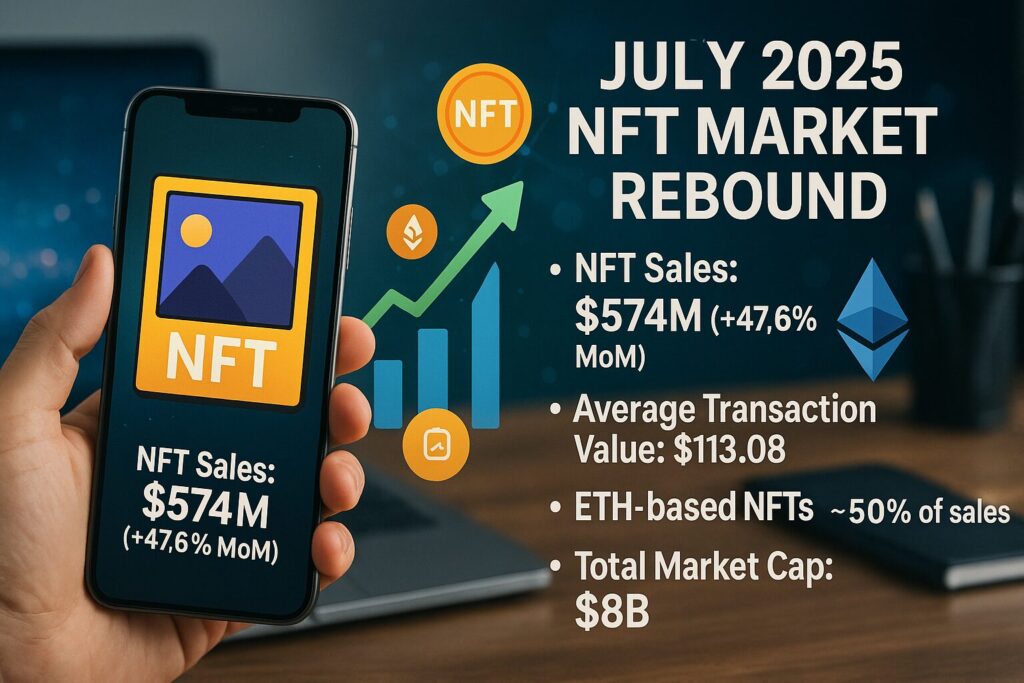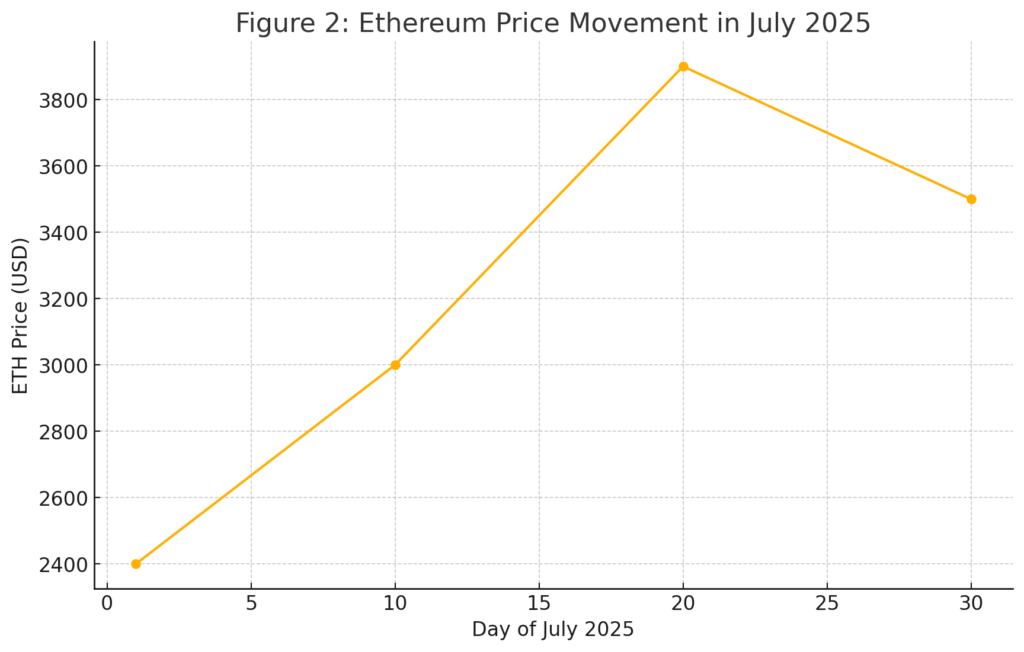
Main Points:
- Surge in NFT Sales: July’s sales hit $574 million, a 47.6% jump from June’s $388.9 million.
- Average Transaction Values Climb: Average sale price rose to $113.08, the highest in six months.
- Buyer–Seller Dynamics Shift: Unique buyers fell 17%, while unique sellers increased 9%, suggesting concentration of large purchases.
- Ethereum Dominance: ETH-based NFTs accounted for nearly half of July’s sales; ETH price soared 62% from $2,400 to $3,900 in July.
- Market Capitalization Growth: Total NFT market cap climbed 21% from $6.6 billion in June to over $8 billion by July.
- Broader Trends: Despite Q2 volume declines, H1 2025 sales reached $2.82 billion; proposals for NFT ETFs could further institutionalize the sector.
- Outlook: Continued ETH price strength and institutional interest may sustain momentum, but volatility and regulatory uncertainties remain.
1. Surge in NFT Sales Volume
July 2025 witnessed a sharp uptick in non-fungible token (NFT) transactions, with total sales reaching $574 million, marking the second-highest monthly tally of the year. This represents a 47.6% increase compared to June’s $388.9 million, though still below January’s peak of $678.9 million. The data, sourced from CryptoSlam, underscore renewed investor interest after a mid-year lull.
[Figure 1: Monthly NFT Sales Volume]

Despite this rebound, broader quarterly trends show a market in transition. DappRadar reports that Q2 2025 trading volumes totaled only $823 million—45% lower than Q1—though transaction counts rose, hinting at sustained demand for accessible, lower-priced NFTs.
2. Rising Average Transaction Values
While overall transaction counts dipped slightly—500 million transactions in July versus 550 million in June—the average sale price climbed to $113.08, the highest level in six months. This shift suggests that, although fewer users are transacting, those who remain are targeting higher-value assets, perhaps reflecting confidence in blue-chip collections like CryptoPunks and Bored Ape Yacht Club (BAYC).
3. Shifting Buyer and Seller Dynamics
July saw 713,085 unique buyers, down 17% from June, while 405,505 unique sellers rose 9% month-over-month. This imbalance implies a consolidation on the buyer side, where a smaller cohort of investors is making larger acquisitions, potentially signaling institutional or “whale” activity in premium NFT segments.
4. Ethereum’s Leading Role
Ethereum’s price surge was a key tailwind. Starting July at $2,400, ETH climbed to over $3,900 by mid-month—a 62% increase—before settling around $3,500 at month’s end. This rally underpinned the dominance of ETH-based NFTs: they generated $275.6 million of sales—almost 50% of the total—and saw a 56% month-over-month increase in trading volume.
[Figure 2: Ethereum Price Movement in July 2025]

Nearly all top-10 collections by market capitalization reside on Ethereum. CryptoPunks led July with $69.2 million in sales, followed by Pudgy Penguins at $55.5 million and Polygon’s Country Yard NFT at $23.8 million. Notably, Pudgy Penguins’ floor price jumped 65.44%, outpacing legacy collections BAYC and MAYC.
5. Overall Market Capitalization Growth
According to NFT Price Floor, the total market capitalization of NFTs exceeded $8 billion by July 24, up 21% from $6.6 billion on July 1. This growth reflects both the Ethereum price rally and targeted buying of high-value assets across leading collections.
6. Context from H1 2025 and ETF Developments
Despite this mid-year uptick, H1 2025 NFT sales totaled $2.82 billion, slightly down from H2 2024’s $2.96 billion but demonstrating resilience in a maturing market. Additionally, Canary Capital’s recent filing for an ETF primarily invested in NFTs marks a watershed moment for institutional access—though critics warn of valuation and liquidity challenges inherent to unique digital assets.
7. Outlook and Risks
The convergence of ETH price strength and growing institutional interest bodes well for continued NFT market expansion. However, potential headwinds include:
- Regulatory Scrutiny: Unclear frameworks around digital assets could introduce compliance hurdles.
- Market Volatility: Rapid ETH price swings may translate into NFT price instability.
- Selective Interest: High-value NFTs lead growth; mass-market segments may see slower expansion.
Investors seeking new crypto assets should monitor ETH technical indicators (recent neutral-bullish signals and moderate volatility) and emerging ETF approvals, while practitioners exploring blockchain applications can leverage NFTs for tokenized assets, digital rights management, and community engagement strategies.

